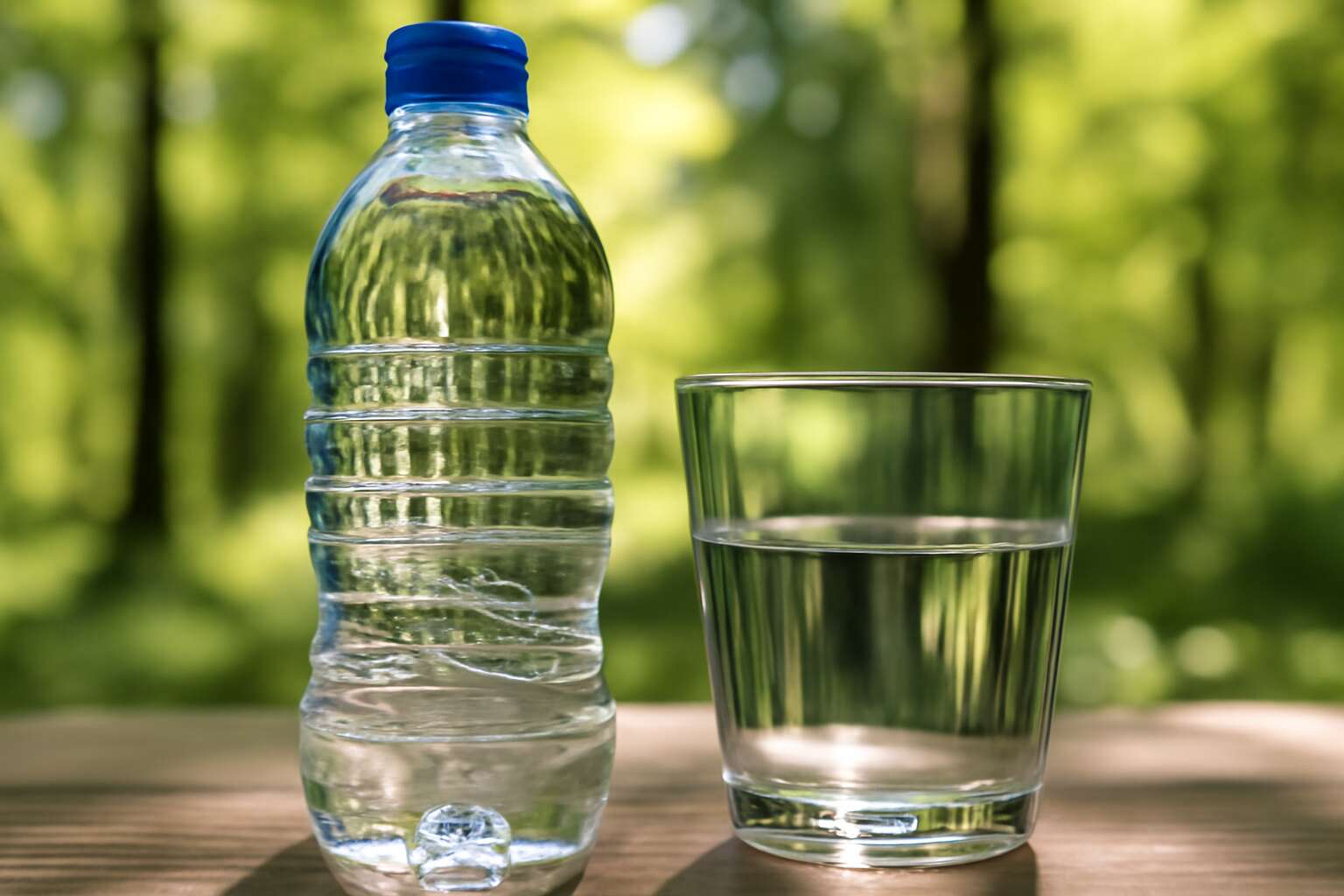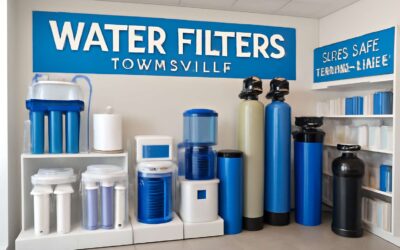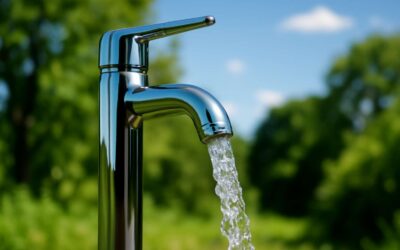Understanding PFAS and Its Presence in Bottled Water
What Are PFAS and Why Are They Concerning?
In the quiet depths of our modern world, a silent specter lurks—PFAS, or per- and polyfluoroalkyl substances, weaving an invisible web through our bottled water. These persistent chemicals, often dubbed “forever chemicals,” resist decay, lingering in our environment like an ominous shadow. Recent studies reveal that bottled water pfas contamination is not just a distant threat; it’s a tangible reality, quietly infiltrating the most pristine-sounding sources.
Why does this matter? Because PFAS are not merely chemicals; they are harbingers of potential health risks, from hormonal disruptions to increased cancer risk. The concern is not just about what’s in the water, but what it signifies—a pervasive contamination that challenges our trust in something as fundamental as drinking water. As we reach for a bottle, we unwittingly become part of a silent narrative—one where bottled water pfas may be more common than we imagine.
Sources of PFAS Contamination in Bottled Water
Understanding PFAS and their presence in bottled water is crucial as these chemicals quietly infiltrate our daily routines. PFAS, or per- and polyfluoroalkyl substances, are not just an environmental concern—they are a direct threat to public health. These substances are often found in manufacturing processes that involve non-stick coatings, stain-resistant fabrics, and firefighting foams. But increasingly, they are seeping into bottled water sources.
The contamination of bottled water pfas primarily occurs through polluted groundwater and surface water sources. Industrial facilities, waste disposal sites, and agricultural runoff contribute significantly to this issue. As the water moves through contaminated environments, PFAS molecules cling to sediments and dissolve into the water itself. This persistent presence makes bottled water pfas a silent but insidious problem—one that is often overlooked by consumers.
To better understand the scope of contamination, consider these common sources of PFAS in bottled water:
- Industrial discharge from manufacturing plants
- Leachate from landfills and waste sites
- Agricultural runoff containing contaminated fertilizers or pesticides
Monitoring efforts reveal that bottled water pfas levels can vary widely depending on the source. Some bottled water brands source their water from pristine springs, yet even these can be compromised when nearby industrial activities introduce PFAS into the environment. The complex pathways of contamination underscore the importance of rigorous testing and regulation to protect consumers from these invisible toxins.
How PFAS Enter Bottled Water Supplies
In the silent depths of our bottled water, an invisible threat often lurks—PFAS, or per- and polyfluoroalkyl substances, have woven themselves into what we consider pure and pristine. These persistent chemicals, once associated with industrial marvels like non-stick coatings and firefighting foams, have a troubling habit of infiltrating groundwater and surface water sources, turning them into unintended reservoirs of contamination.
How do PFAS find their way into bottled water supplies? The pathways are as intricate as a spider’s web, often involving a series of environmental breaches. Industrial discharge, leachate from landfills, and agricultural runoff—especially from contaminated fertilizers and pesticides—are primary culprits. Once in the water cycle, PFAS molecules cling tenaciously to sediments or dissolve directly into water, quietly contaminating sources that many assume are safe.
Monitoring efforts reveal a disturbing reality: bottled water pfas levels can vary dramatically depending on the source. Even water from seemingly untouched springs may harbor these silent toxins if nearby industries or waste sites have tainted the environment. This complex web of contamination underscores the urgent need for rigorous testing and stricter regulation, as the presence of bottled water pfas persists as an uninvited guest in our daily lives.
Health Risks Associated with PFAS in Bottled Water
Potential Health Effects of PFAS Exposure
When it comes to bottled water pfas, the potential health risks are no longer just a conspiracy theory whispered in the shadows of environmental circles. These stubborn chemicals, known for their persistence, can silently infiltrate our bodies, leaving a trail of concern that’s hard to ignore. Exposure to PFAS in bottled water has been linked to a range of health effects that make you pause—think immune system disruptions, hormonal imbalances, and even increased cancer risks. It’s as if these invisible contaminants are playing a game of hide-and-seek within what we consider a simple refreshment.
The danger lies not only in their toxicity but also in their bioaccumulation. Once ingested, PFAS can linger in the body for years, quietly mounting up with each sip. Some studies suggest that long-term exposure to bottled water pfas may lead to serious health conditions, including kidney and liver damage, and developmental issues in children. Given the ubiquity of bottled water, the potential health effects of PFAS exposure become a pressing concern for consumers eager to hydrate without complexity or risk. It’s a reminder that sometimes, the most innocent-looking bottled water could harbor more than just H2O.
Vulnerable Populations and Risks
Certain groups are particularly susceptible to the insidious effects of bottled water pfas, making their vulnerability a cause for heightened concern. Children, pregnant women, and individuals with compromised immune systems face a disproportionate risk. Their developing bodies and immune defenses are less equipped to handle these persistent chemicals, which can subtly interfere with growth and immune responses.
For vulnerable populations, even low levels of bottled water pfas could pose significant health threats over time. The bioaccumulative nature of PFAS means that repeated exposure—such as daily bottled water consumption—could lead to long-term health issues. These risks are compounded by the fact that bottled water, often perceived as a safer alternative, might harbor unseen contaminants like bottled water pfas, silently impacting health.
- Children’s developing organs are more sensitive to chemical disruptions caused by bottled water pfas.
- Pregnant women exposed to bottled water pfas risk affecting fetal development and hormonal balance.
- Immunocompromised individuals may experience weakened defenses due to chemical interference from bottled water pfas.
Understanding these risks underscores the importance of scrutinizing bottled water sources, especially for those most at risk. The presence of bottled water pfas adds a layer of complexity to what many consider a simple hydration choice, revealing that even our most basic health safeguards require careful consideration.
Research and Studies on PFAS in Bottled Water
Research continually uncovers unsettling truths about bottled water pfas, revealing that these persistent chemicals are more than mere contaminants—they are silent invaders capable of affecting long-term health. Several scientific studies point to the bioaccumulative nature of PFAS, demonstrating how even trace amounts in bottled water can build up in the human body over time, especially with daily consumption. The health risks associated with bottled water pfas are particularly concerning for vulnerable populations, such as children and pregnant women. For instance, exposure during early developmental stages can subtly interfere with organ formation and hormonal balance, with potential lifelong consequences.
Studies indicate that the presence of bottled water pfas is not an isolated anomaly but part of a broader pattern of environmental contamination. Researchers have detected PFAS in bottled water samples from different regions, emphasizing the pervasive nature of this issue. The challenge lies in the difficulty of removing these chemicals through standard filtration processes, which makes the presence of bottled water pfas a hidden threat lurking in what many perceive as a safe hydration source. As awareness grows, so does the imperative to scrutinize bottled water sources more critically, especially as the long-term health implications continue to surface in scientific discourse.
Regulations and Standards for PFAS in Bottled Water
Current Regulations and Limits
Regulations surrounding PFAS in bottled water have become a critical focus in recent years, especially as awareness of bottled water PFAS contamination increases. Despite the global concern, current standards remain inconsistent, often lagging behind scientific understanding. In South Africa, regulatory bodies have begun to scrutinize the presence of PFAS compounds, but comprehensive limits are still evolving to match the complexity of these persistent chemicals.
Across many markets, there is a growing call for strict limits to safeguard consumers. For example, some regions have adopted guidelines that set maximum allowable concentrations for PFAS, but these are often based on limited data and may not fully account for long-term health effects. To address this, authorities are increasingly pushing for harmonized international standards, recognizing that bottled water pfas is an issue that transcends borders.
- Monitoring and testing protocols for bottled water pfas
- Establishment of enforceable maximum contaminant levels
- Increased transparency and public reporting
As the science advances, regulations are expected to tighten. For consumers, understanding the current standards is vital, especially when bottled water pfas levels fluctuate from one brand to another. The ongoing debate underscores the importance of vigilance and rigorous oversight in ensuring safe drinking water for all.
Gaps in Regulatory Oversight
Regulatory oversight of bottled water PFAS remains an intricate patchwork, often lacking the cohesion necessary to confront the pervasive persistence of these chemicals. Despite mounting scientific evidence highlighting their long-term health implications, many jurisdictions have yet to establish enforceable maximum contaminant levels that adequately address the threat. In South Africa, regulatory bodies are beginning to recognize the urgency but are hampered by evolving standards that struggle to keep pace with emerging research.
The disparity in regulations creates a significant gap in consumer protection, leaving bottled water pfas levels vulnerable to fluctuation and inconsistency. It’s not uncommon to encounter brands that operate in regulatory grey areas, where testing protocols are sporadic and transparency is limited. To bridge this divide, some advocate for the adoption of harmonized international standards, which could serve as a universal benchmark for safe bottled water pfas levels. Such standards would ideally include:
- Rigorous monitoring and testing protocols
- Clear, enforceable maximum contaminant levels
- Mandatory public reporting and transparency
Yet, without a global consensus, the regulation of bottled water pfas remains fragmented, with gaps that could allow contamination to silently persist. As scientific understanding deepens, the push for tighter controls intensifies—highlighting the critical need for comprehensive oversight that truly safeguards public health amid the silent threat of bottled water pfas.
International Perspectives on PFAS Standards
Across the globe, regulatory standards for bottled water PFAS often resemble a patchwork quilt—diverse, inconsistent, and sometimes downright confusing. While some nations set strict limits, others merely dabble in minimal oversight, leaving consumers vulnerable to undetected contamination. In South Africa, efforts are underway to tighten regulations, but the evolving standards struggle to keep pace with the rapid pace of scientific discoveries surrounding bottled water PFAS.
International perspectives reveal a fascinating mosaic of approaches. Countries like the United States and members of the European Union have begun to adopt or consider harmonized standards that include:
- Rigorous testing protocols
- Enforceable maximum contaminant levels
- Mandatory public transparency
Yet, without a cohesive global framework, bottled water pfas regulation remains fragmented—an invisible threat lurking beneath the surface of what many assume to be pristine hydration. As awareness grows, so does the call for uniform standards that truly protect consumers from the silent menace of bottled water PFAS.
Testing and Detecting PFAS in Bottled Water
Methods for PFAS Detection
Detecting PFAS in bottled water requires sophisticated analytical methods that can identify these persistent chemicals at incredibly low concentrations. Given that PFAS are often present in trace amounts, traditional testing techniques may fall short in providing accurate results. Modern laboratories employ advanced techniques such as liquid chromatography-tandem mass spectrometry (LC-MS/MS), which can detect PFAS with remarkable sensitivity and precision. These methods are essential for ensuring bottled water pfas levels remain within safe limits and for building trust among consumers.
To enhance detection accuracy, laboratories often follow a rigorous process that involves sample preparation, extraction, and purification before analysis. This meticulous approach minimizes potential interference from other substances and ensures the reliability of the results. When testing for PFAS, analysts typically focus on a specific suite of chemicals known for their persistence and toxicity, including perfluorooctanoic acid (PFOA) and perfluorooctanesulfonic acid (PFOS). The adoption of these advanced detection methods is crucial in safeguarding public health and maintaining transparency in bottled water quality.
How Consumers Can Identify Contaminated Bottled Water
In a world where bottled water is often seen as the purest choice, the lurking threat of bottled water PFAS contamination demands our attention. Yet, how can consumers truly identify whether their bottled water is free from these persistent chemicals? The answer lies in understanding the intricacies of PFAS detection methods. Modern laboratories utilize highly sensitive techniques like liquid chromatography-tandem mass spectrometry (LC-MS/MS), capable of uncovering even trace amounts of these toxic substances.
Consumers seeking reassurance can look for transparency from manufacturers regarding their testing practices. Some brands may provide detailed reports on their bottled water PFAS levels, showcasing compliance with safety standards. When in doubt, requesting third-party laboratory analyses can be an eye-opening step. These reports often highlight a specific suite of chemicals, including PFOA and PFOS, which are commonly associated with bottled water PFAS contamination. Awareness of these details helps consumers navigate the complex landscape of bottled water quality and make informed choices amidst the silent threat of PFAS.
Importance of Regular Testing and Certification
In a landscape where bottled water is often perceived as the pinnacle of purity, the insidious presence of bottled water PFAS threatens that very trust. Regular testing and certification are not just bureaucratic formalities—they are vital safeguards to ensure water safety. Without consistent analysis, contaminants can sneak into bottles, posing serious health risks that many consumers remain unaware of.
Advanced detection methods, such as liquid chromatography-tandem mass spectrometry (LC-MS/MS), are essential tools for identifying trace levels of bottled water PFAS. These techniques can detect even minuscule amounts of chemicals like PFOA and PFOS, which have been linked to adverse health effects. Moreover, transparency from brands regarding their testing practices builds consumer confidence and fosters accountability.
Some brands go further by providing detailed third-party laboratory reports, demonstrating their commitment to safety. These certifications act as a crucial line of defense—empowering consumers to make informed decisions amidst the often invisible threat of bottled water PFAS. Ultimately, regular testing and certification are the cornerstone of ensuring bottled water remains the safe, reliable choice it claims to be.
How to Reduce PFAS Exposure from Bottled Water
Choosing PFAS-Free Bottled Water Brands
In a world increasingly conscious of what we sip, choosing bottled water free from PFAS becomes a vital act of self-preservation. With studies revealing that PFAS can linger in water supplies, selecting brands committed to purity is more than a preference—it’s a safeguard. Fortunately, some bottled water brands have taken steps to eliminate PFAS from their sources, offering consumers a safer alternative amidst the murky waters of contamination.
To reduce PFAS exposure from bottled water, it’s essential to scrutinize the brands you trust. Seek companies that publish transparent testing results and adhere to rigorous standards for water purity. Many reputable brands now undergo third-party testing to certify their bottled water is free from PFAS. Additionally, some brands employ advanced filtration techniques such as activated carbon or reverse osmosis, which are effective in removing these persistent chemicals.
When selecting bottled water, consider checking for certifications or seals indicating PFAS-free assurance. An informed choice often begins with reading labels and researching a brand’s commitment to water safety. Remember, opting for bottled water brands that prioritize environmental and health standards not only reduces your PFAS exposure but also supports companies dedicated to transparency and sustainability.
Alternative Water Filtration Methods
When it comes to safeguarding your health from bottled water PFAS, exploring alternative water filtration methods can be a game-changer. These techniques act as an invisible shield, stripping away those persistent chemicals that lurk unseen in water supplies. Advanced filtration systems like activated carbon filters and reverse osmosis units have gained recognition for their remarkable ability to reduce bottled water PFAS effectively. They work by trapping or dissolving these stubborn compounds, transforming contaminated water into a source of genuine purity.
Implementing these filtration methods at home or in small-scale setups can be a strategic move, especially if you’re concerned about the unseen dangers lurking within bottled water sources. For example, an ordered process can help you understand how to approach this task:
- Research high-quality activated carbon filters known for PFAS removal.
- Invest in reverse osmosis systems designed specifically to target chemical contaminants.
- Regularly maintain and replace filters to ensure their efficacy remains at peak performance.
By embracing these alternative water filtration methods, consumers can take proactive steps to diminish their exposure to bottled water PFAS. These systems not only elevate water purity but also empower you to make informed choices in a landscape riddled with contamination worries.
Advocacy and Supporting Regulatory Changes
Confronted with the silent menace of bottled water PFAS, advocacy becomes a moral imperative. Every voice raising awareness, every campaign pressing for change, chips away at the invisibility of this pervasive threat. We must push for transparency—demanding that bottled water companies disclose their testing results for PFAS and other chemical contaminants. Supporting regulatory changes is not just a matter of policy; it’s a stand for health, for future generations, and for ethical stewardship of our water resources.
Engaging with local and international bodies to tighten standards can catalyze meaningful reform. Mobilize community efforts to advocate for stricter limits on bottled water PFAS, emphasizing the urgency of comprehensive testing and certification. These collective voices can influence legislation and foster accountability, shaping a landscape where bottled water is no longer a vessel for unseen toxins but a symbol of purity and trust.
- Participate in public consultations on water safety regulations.
- Support NGOs that champion clean water initiatives and transparency.
- Encourage policymakers to prioritize bans or limits on PFAS in bottled water production.
Future Trends and Innovations in Bottled Water Safety
Emerging Technologies for PFAS Removal
As shadows lengthen and the murmur of unseen threats grows louder, the future of bottled water safety hinges on the emergence of cutting-edge technologies to combat PFAS contamination. Innovations in PFAS removal are no longer mere whispers in the dark—they are becoming the beacon of hope for consumers craving purity in every sip. Emerging methods such as advanced activated carbon, ion exchange resins, and novel nanomaterials promise to pierce the veil of these persistent pollutants, offering a glimmer of reassurance in an otherwise opaque landscape.
In the realm of bottled water pfas, innovation is driven by a relentless pursuit of perfection. Researchers are now exploring multi-stage filtration systems, integrating several technologies in harmony to obliterate even the most insidious PFAS compounds. This layered approach ensures a more thorough cleanse, pushing the boundaries of what bottled water can become—an untainted sanctuary in a contaminated world.
Furthermore, the future may witness the rise of smart detection devices, capable of real-time monitoring of PFAS levels at the point of bottling. Such technological marvels could revolutionize transparency, enabling producers to verify purity instantaneously and assure consumers that their water remains free from this silent menace. The convergence of innovation and vigilance offers a tantalizing glimpse into a future where bottled water is not just a source of hydration but a fortress of safety against the unseen toxins lurking beneath the surface.
Industry Initiatives to Minimize PFAS Contamination
The future of bottled water safety in South Africa teeters on the cusp of a technological renaissance. As the shadows of PFAS contamination deepen, industry leaders and innovators are forging new pathways to safeguard purity and transparency. Emerging trends in the bottled water pfas industry are driven by an unyielding quest for perfection—where science meets the art of filtration, and vigilance becomes an everyday ritual.
One of the most promising innovations involves multi-stage filtration systems that seamlessly combine advanced activated carbon, ion exchange resins, and cutting-edge nanomaterials. This layered approach ensures even the most insidious PFAS compounds are captured, transforming bottled water from a simple beverage into a veritable fortress of purity. Such technological sophistication pushes the boundaries of what bottled water can be—truly a sanctuary amid a polluted landscape.
Looking ahead, real-time monitoring devices are poised to revolutionize transparency in the bottled water pfas industry. Imagine smart sensors at the point of bottling, capable of instantaneously verifying PFAS levels with unerring precision. These innovations could herald an era where consumers no longer rely solely on regulatory assurances but are empowered to scrutinize the safety of their water in real time. As these technologies converge, the industry moves closer to an unblemished promise: bottled water that is not only refreshing but unwaveringly safe, even in the face of unseen threats.
The Role of Consumer Awareness and Education
As technology advances, the future of bottled water safety hinges on innovation and heightened consumer awareness. Emerging trends in the bottled water pfas industry focus on empowering consumers to make informed choices. With the rise of real-time monitoring devices, bottling companies are increasingly adopting smart sensors capable of instant PFAS detection, ensuring transparency at every step of the supply chain.
Such innovations not only bolster regulatory compliance but also foster consumer trust. An informed public can demand higher standards and push brands toward safer practices. For example, understanding how to identify bottled water pfas contamination or recognizing brands that prioritize PFAS-free certification becomes a vital part of everyday decision-making. Transparency isn’t just a regulatory obligation; it’s a cornerstone of modern bottled water safety.
In South Africa, where water quality concerns are often intertwined with environmental and infrastructural challenges, consumer education takes on even greater significance. Awareness campaigns highlighting the importance of choosing PFAS-free bottled water and supporting regulatory reforms can help mitigate risks. As the industry evolves, the synergy between technological innovation and educated consumers promises a future where bottled water is not only refreshing but also truly safe from PFAS contamination.




0 Comments